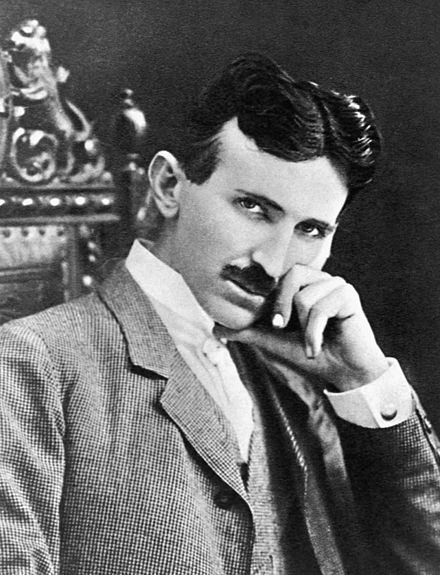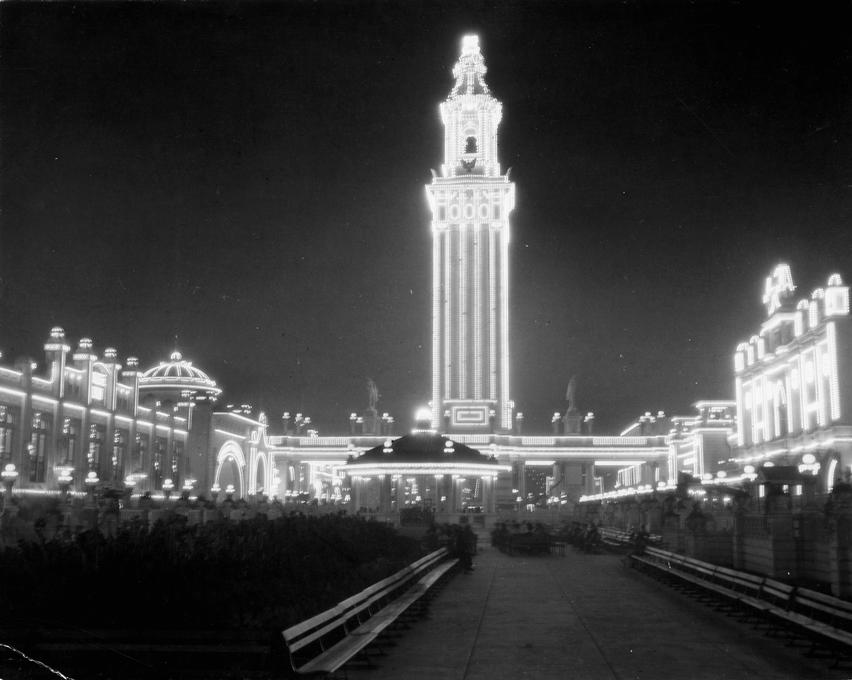NIKOLA TESLA: FROM THE WHITE CITY TO TODAY, STILL MAKING AN IMPACT ON CHICAGO
I’m sure you’ve seen the Tesla automobile alongside you while cruising down Lakeshore Drive, but Nikola Tesla’s influence on the city of Chicago stretches much farther back in our history, changing our world in 1893.
NIKOLA TESLA: FROM THE WHITE CITY TO TODAY, STILL MAKING AN IMPACT ON CHICAGO
I’m sure you’ve seen the Tesla automobile alongside you while cruising down Lakeshore Drive, but Nikola Tesla’s influence on the city of Chicago stretches much farther back in our history, changing our world in 1893.

From a young age, Nikola Tesla was obsessed with electricity. Born in modern day Croatia, Tesla moved to the states at age 28 arriving in New York City with only 4 cents in his pocket and a letter of recommendation. He began working under Thomas Edison who was making tremendous developments with electricity using Direct Current backed by investor JP Morgan. Tesla saw a different vision for the future of electricity, that being the more powerful Alternating Current, which he believed to be more efficient and safer than DC. Resigning from Edison’s workshop to be able to pursue AC, Tesla gains support from George Westinghouse beginning what is referred to as the “war of currents”. The turning point in the battle of AC versus DC would be the host of the Columbian Exposition of 1893, a celebration of the 400th anniversary of Christopher Columbus setting foot on the New World (one year late). Of the cities that bid to host the Columbian Exposition, including St. Louis, New York, Washington D.C., and Chicago, Chicago was granted that privilege. Considering the entire city was completely burned down just a short twenty-two years earlier in the devastating Great Fire of 1871, this surely granted Chicago the ability to boast, giving rise to one of its many nicknames, the “Windy City.”
Hosted on Chicago’s Lakefront making access by boat, road, and rail possible, the fair would attract 27.5 million viewers with the cultural achievements from every corner of the globe put on display. The fair was to give a peek into the future of America while showcasing the American Industrial Revolution. Director and building architect Daniel Burnham had a vision of grandeur exhibited over 600 acres and including 200 buildings. The architecture incorporated the style that he knew best, Beaux Arts also referred to as French Neoclassicism, reflecting our antiquities accentuating balance, symmetry, and perfection of our past. Illuminating the fair and giving its visitors their first glimpse of glowing lightbulbs would prove to be one of the most important decisions to the future of electricity. Edison and JP Morgan under General Electric Company first made a bid of 1.8 million dollars to power the fair and then reduced the price to $554,000. Tesla and George Westinghouse claimed they could illuminate the fair for only $399,000 securing their role in providing electricity to Chicago and its many visitors.

From a young age, Nikola Tesla was obsessed with electricity. Born in modern day Croatia, Tesla moved to the states at age 28 arriving in New York City with only 4 cents in his pocket and a letter of recommendation. He began working under Thomas Edison who was making tremendous developments with electricity using Direct Current backed by investor JP Morgan. Tesla saw a different vision for the future of electricity, that being the more powerful Alternating Current, which he believed to be more efficient and safer than DC. Resigning from Edison’s workshop to be able to pursue AC, Tesla gains support from George Westinghouse beginning what is referred to as the “war of currents”. The turning point in the battle of AC versus DC would be the host of the Columbian Exposition of 1893, a celebration of the 400th anniversary of Christopher Columbus setting foot on the New World (one year late). Of the cities that bid to host the Columbian Exposition, including St. Louis, New York, Washington D.C., and Chicago, Chicago was granted that privilege. Considering the entire city was completely burned down just a short twenty-two years earlier in the devastating Great Fire of 1871, this surely granted Chicago the ability to boast, giving rise to one of its many nicknames, the “Windy City.”
Hosted on Chicago’s Lakefront making access by boat, road, and rail possible, the fair would attract 27.5 million viewers with the cultural achievements from every corner of the globe put on display. The fair was to give a peek into the future of America while showcasing the American Industrial Revolution. Director and building architect Daniel Burnham had a vision of grandeur exhibited over 600 acres and including 200 buildings. The architecture incorporated the style that he knew best, Beaux Arts also referred to as French Neoclassicism, reflecting our antiquities accentuating balance, symmetry, and perfection of our past. Illuminating the fair and giving its visitors their first glimpse of glowing lightbulbs would prove to be one of the most important decisions to the future of electricity. Edison and JP Morgan under General Electric Company first made a bid of 1.8 million dollars to power the fair and then reduced the price to $554,000. Tesla and George Westinghouse claimed they could illuminate the fair for only $399,000 securing their role in providing electricity to Chicago and its many visitors.

Opening day, May 1st 1893, in one of the most stunning displays of technology ever seen to this point, Chicago’s World’s Fair provided the backdrop for 200,000 lightbulbs to come to life all made by Westinghouse Corporation from scratch. When the “millions of lights were suddenly flashed on, all at one time…[it] was like getting a sudden vision of Heaven,” recalled Hilda Satt. The now “White City” was literally glowing with all of its white buildings accented with white lights. The well-lit city made for a safe and enjoyable environment encouraging visitors to engage well into the night. “If evenings at the fair were seductive, the nights were ravishing.” By the closing of the World’s Fair, Tesla had proved the safety and stability of AC through the millions of Westinghouse lightbulbs that were displayed setting the foundation of what would come to be the standard of electric power today.
Nikola Tesla would go on to make several innovative inventions, most of which were not fully understood during his lifetime. His perceptive and imaginative ideas have had a profound impact on our world. Tesla Motors, Inc., an American automotive and energy storage company, is melding the visionary concepts of Nikola Tesla with the world’s new consciousness towards the environment. Each light bulb created for the fair would need to be replaced every five hours and now, less than 150 years later, there are electric sports cars with instant torque, unbelievable power, and zero emissions powered by lithium ion batteries using the concepts first perceived by Tesla.
While tremendous strides are being made to automobiles by Tesla Motors, sustaining the environment is also a vision of Chicago Line Cruises, the industry innovator of architectural river cruises in Chicago. Their newest boat in the making, Ceres, will be the largest passenger vessel to pass under Chicago’s bascule bridges powered by 50 tons of lithium ion batteries sustaining up to 12 hours of sailing and to be re-charged by wind. In the city that allowed Tesla the opportunity to showcase his electric vision, its waters will soon continue to show his influence while respecting its environment through Ceres.

Opening day, May 1st 1893, in one of the most stunning displays of technology ever seen to this point, Chicago’s World’s Fair provided the backdrop for 200,000 lightbulbs to come to life all made by Westinghouse Corporation from scratch. When the “millions of lights were suddenly flashed on, all at one time…[it] was like getting a sudden vision of Heaven,” recalled Hilda Satt. The now “White City” was literally glowing with all of its white buildings accented with white lights. The well-lit city made for a safe and enjoyable environment encouraging visitors to engage well into the night. “If evenings at the fair were seductive, the nights were ravishing.” By the closing of the World’s Fair, Tesla had proved the safety and stability of AC through the millions of Westinghouse lightbulbs that were displayed setting the foundation of what would come to be the standard of electric power today.
Nikola Tesla would go on to make several innovative inventions, most of which were not fully understood during his lifetime. His perceptive and imaginative ideas have had a profound impact on our world. Tesla Motors, Inc., an American automotive and energy storage company, is melding the visionary concepts of Nikola Tesla with the world’s new consciousness towards the environment. Each light bulb created for the fair would need to be replaced every five hours and now, less than 150 years later, there are electric sports cars with instant torque, unbelievable power, and zero emissions powered by lithium ion batteries using the concepts first perceived by Tesla.
While tremendous strides are being made to automobiles by Tesla Motors, sustaining the environment is also a vision of Chicago Line Cruises, the industry innovator of architectural river cruises in Chicago. Their newest boat in the making, Ceres, will be the largest passenger vessel to pass under Chicago’s bascule bridges powered by 50 tons of lithium ion batteries sustaining up to 12 hours of sailing and to be re-charged by wind. In the city that allowed Tesla the opportunity to showcase his electric vision, its waters will soon continue to show his influence while respecting its environment through Ceres.
Sources:
City of the Century: The Epic of Chicago and the Making of America by Donald Miller
Devil in the White City: Murder, Magic, and Madness at the Fair that Changed America by Eric Larsen
The Men who Built America documentary by the History Channel
Images:
University of Chicago Photographic Archive, [apf digital item number, e.g., apf12345], Special Collections Research Center, University of Chicago Library.
Written by Amy, Docent for Chicagoline Cruises
Sources:
City of the Century: The Epic of Chicago and the Making of America by Donald Miller
Devil in the White City: Murder, Magic, and Madness at the Fair that Changed America by Eric Larsen
The Men who Built America documentary by the History Channel
Images:
University of Chicago Photographic Archive, [apf digital item number, e.g., apf12345], Special Collections Research Center, University of Chicago Library.
Written by Amy, Docent for Chicagoline Cruises